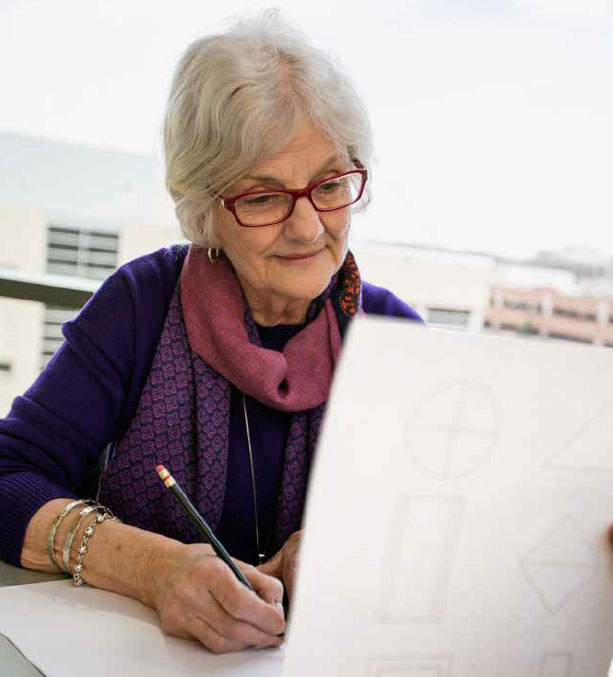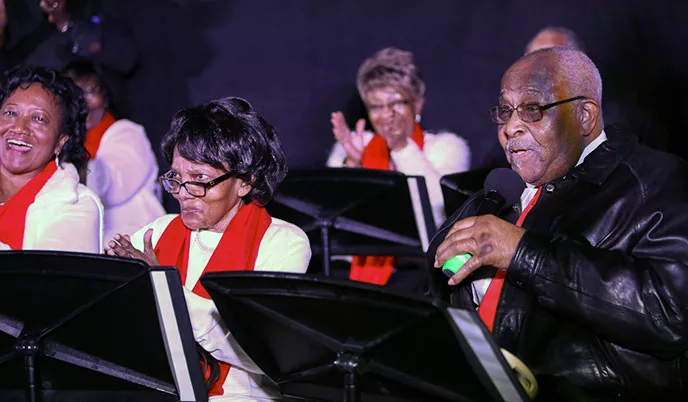Alumni Lead Two UW Academic Campuses
Distinguished University of Wisconsin School of Medicine and Public Health alumni hold top leadership roles at two of the health care systems within the school’s Statewide Campus.
Over the past decade, as part of the Wisconsin Registry for Alzheimer’s Prevention (WRAP) study, Sigrid Knuti has given blood and spinal fluid, run on treadmills, had her brain imaged and participated in timed memory tests so difficult they sometimes made her cry.

Sometime this year, she’ll be assessed to see whether she can join yet another UW–Madison study, dubbed the A4 drug trial, this one to test an experimental drug that may help slow the progress of Alzheimer’s.
Knuti calls herself “a member of a club I never wanted to join.”
But she and hundreds of other members of that club — adults whose parents have or had Alzheimer’s disease — are partnering with the University of Wisconsin School of Medicine and Public Health in the effort to better prevent, diagnose and treat Alzheimer’s disease.
“I don’t think there’s going to be a cure in time for me,” says Knuti, who is still sharp at age 74. “But I want my generation to be the last with this disease. I’m participating in this research for my daughters.”
Knuti, her sister Karin Lange and their husbands are among 1,500 participants enrolled in the WRAP study of middle-aged people at risk of developing Alzheimer’s. As daughters of a mother who had the disease, they are in the at-risk arm; their husbands are controls. Another 300 people take part in a different UW School of Medicine and Public Health-based study, the IMPACT study, which also recruits subjects at increased risk for Alzheimer’s and will continue doing so until it reaches almost 700 subjects. Once enrolled, these subjects and those in WRAP will form the largest and longest-studied cohort in the world of middle-aged adults at increased risk for non-familial, sporadic Alzheimer’s disease.
These long-running cohort studies are a small sampling of UW–Madison’s unique assets that share related goals. These include the National Institutes of Health-funded Wisconsin Alzheimer’s Disease Research Center (ADRC); Wisconsin Alzheimer’s Institute (WAI), which leads a statewide network of 44 diagnostic clinics; a faculty of 21 principal investigators working on research across campus; and laboratories with cutting-edge imaging equipment.
The breadth is astounding. A five-minute walk around campus could take you to the laboratory of Luigi Puglielli, MD, PhD, a professor in the Division of Geriatrics and Gerontology in the Department of Medicine and member of the ADRC, who has a mouse model of Alzheimer’s disease. He found a compound that, when fed to the mice, reduced beta amyloid and tau proteins, which are Alzheimer’s-related proteins that build up in the brain. Nearby, his colleague Amy Kind, MD ’01, PhD ’11, an associate professor in the same division, has a federal grant to improve the care of dementia patients when they return home from the hospital. Kind has shown that home follow-up by nurses — via phone or, if necessary, in person — can keep people healthier than those who are not followed and can dramatically reduce hospital readmissions. Just a short walk from her lab, you’ll find a brain bank, where about 120 of the more than 200 donated human brains having the “gold standard” of an Alzheimer’s diagnosis are available for study.
I want my generation to be the last with this disease. I’m participating in this research for my daughters.
- Sigrid Knuti
Richard Moss, PhD, UW School of Medicine and Public Health senior associate dean for basic research, biotechnology and graduate studies, believes UW–Madison is uniquely positioned to help stem the coming tsunami of dementia. The national Alzheimer’s Association says the number of people age 65 and older who have Alzheimer’s disease may nearly triple by 2050 to a projected 13.8 million.
“No place else has the resources we do, ’ says Moss. “We have all the pieces: basic science research, clinical trials and long- running cohort studies that began before the participants started showing symptoms. And we have the key public health piece: our network of memory clinics across Wisconsin through which we are able to quickly move what we discover about interventions and treatment into the community. This is truly the Wisconsin Idea in action.”
In 2015, Sanjay Asthana, MD, the Duncan G. and Lottie H. Ballantine Chair in Geriatrics, a professor in the Department of Medicine and head of the Division of Geriatrics and Gerontology, was named the UW School of Medicine and Public Health’s first associate dean for gerontology. He heads the ADRC, a unique program that combines academic, clinical and research expertise at the school and the Geriatric Research, Education and Clinical Center at the adjacent William S. Middleton Memorial Veterans Hospital.
Established in 2009 under Asthana’s leadership, the ADRC team is dedicated to creating a total systems approach to Alzheimer’s disease diagnosis, treatment, prevention, education and research. The nationally designated center of excellence has more than $88 million in federal funding and supports collaborative, interdisciplinary studies with investigators based locally, nationally and internationally.
“UW–Madison is unique in the world, ’ says Asthana, who also cares for dementia patients at the UW Health Memory Assessment Clinic. “We are especially known for our studies of people with preclinical disease, but we have a full spectrum of research, from molecular biology to translational and clinical studies aimed at improving care and health services for people who have dementia.”
Moss and Asthana say translating this research into everyday health care will be enhanced with the recent naming of Jane Mahoney, MD (PG ’89), to lead the Wisconsin Alzheimer’s Institute. A professor in the
Department of Medicine, Mahoney is a geriatrician who leads research and outreach programs focused on healthy aging and improved health care for older adults. She is known internationally for disseminating research to prevent falls, and her successful program has expanded throughout the country. She has a strong background working with public health constituents, such as the state- and county-level Aging Network, and groups like the Alzheimer’s Association.
Mahoney says she feels fortunate to take over the WAI from its founding director, Mark Sager, MD (PG ’87), who started the statewide network of diagnostic clinics.
A UW School of Medicine and Public Health professor emeritus, Sager also established the WRAP study in 2000 by recruiting adult children who were bringing their parents to be assessed at the clinics. Mahoney agrees with Moss and Asthana that nowhere else in the nation is there a diagnostic clinic network like this.
“In addition to putting us in touch with patients and providing state-of-the-art care, it allows us to extend research on supporting caregivers and delaying the time when patients enter nursing homes,” she says.
Beyond the clinics and research cohort, the WAI and ADRC are strongly committed to working on health disparities associated with Alzheimer’s disease. African-Americans have double the risk of developing the disease, and they are less likely to seek help. The WAI’s office in Milwaukee, Wisconsin, headed by Gina Green-Harris, MBA, helps African- American families get to the diagnostic clinics, connects families to local resources from the point of diagnosis to the end of the spectrum of long-term care, and provides families with one-on-one assistance to guide them through the health care systems.
The Amazing Grace Choir (see sidebar on the next page) is an example of a successful WAI outreach project.
Together with the WAI, the Wisconsin ADRC supports extensive outreach and community events to educate and increase recruitment of minority individuals from Madison and surrounding areas in center- supported research studies. Altogether, hundreds of African-American older adults and their families receive early and personalized care for the disease, and many are enrolled in research studies to identify novel genetic, medical, lifestyle, socioeconomic and other factors specifically related to increased risk of Alzheimer’s disease in these participants.
A major mission of the Alzheimer’s program is to train the next generation of academic geriatrics clinicians. The WAI runs a student interest group and New Friends Program, which matches health professions students with people in the early stages of Alzheimer’s disease. It has helped place 30 medical students in summer geriatrics- related externships, including time in Milwaukee, Rhinelander and Richland Center, Wisconsin. The WAI trains staff of the 44 diagnostic clinics through several sessions per year, and the ADRC trains physicians and doctoral-level scientists who wish to pursue academic careers in geriatrics and dementia research. Many scientists have been trained, and several are working at UW–Madison and other institutions across the nation.
The WAI’s WRAP study is starting to reveal intriguing data about the onset of Alzheimer’s disease. For instance, through use of the latest diagnostic techniques, studies of WRAP participants show that Alzheimer’s-associated brain changes begin 10 to 20 years earlier than when symptoms are diagnosed. These brain differences include volume changes in key areas such as the hippocampus, connectivity changes in the white matter, metabolic alterations and amyloid plaque build-up.
WRAP researchers have shown that metabolic syndrome, uncontrolled diabetes and disrupted sleep in middle age are associated with dementia.
On the positive side, WRAP is yielding some good tips to help preserve brain health. Studies led by Ozioma Okonkwo, PhD, and others have shown that physical activity and cardiovascular fitness can delay brain changes, and cognitive activities such as playing challenging games and doing puzzles seem to help. An assistant professor in the Division of Geriatrics and Gerontology, Okonkwo is running a study funded by the Alzheimer’s Association to see if physical activity can prevent symptoms from appearing.
All the data on WRAP participants has drawn international attention from researchers interested in “big-data” analysis, leading the UW School of Medicine and Public Health to form a partnership called Swoop-Med to interrogate the data in a way that makes it easier to search for clues to better target diagnosis and treatment.
When we identify cognitive decline, we can look back at data from earlier visits and determine which features might predict future symptomatic disease.
- Sterling Johnson
Sterling Johnson, PhD, the Jean R. Finley Professor of Geriatrics and Dementia in the Division of Geriatrics and Gerontology, associate director of the ADRC and the principal investigator of the WRAP study, says perhaps WRAP’s greatest contribution is its wealth of data, going back an average of nine years for each participant and including blood samples, spinal fluid and other biomarkers, plus cognitive test results and lifestyle and health information.
“This can help us pinpoint factors that confer risk or resilience,” Johnson says. “When we identify cognitive decline, we can look back at data from earlier visits and determine which features might predict future symptomatic disease.”
Johnson is using imaging tools to search for early biomarkers of Alzheimer’s disease in the brain—the amyloid plaques and neurofibrillary tangles that previously weren’t seen until autopsy. He hopes this will lead to earlier diagnosis and treatment, as well as a better chance to enroll into the studies people who are on a pathway to Alzheimer’s.
While past years have yielded important clues, there’s still no cure and no effective treatment for the disease. Cindy Carlsson, MD (PG ’98), an associate professor in the Division of Geriatrics and Gerontology who is running the Wisconsin site for the A-4 drug trial, remains optimistic. “I think in five years we’re going to have the results back from some of these large trials, and we’ll know if we’re on the right track with targeting these amyloid proteins,” she says. “We’ll have a better understanding of the factors that lead to Alzheimer’s. It may seem like we are taking baby steps, but we have a much better understanding of the disease than we did 10 years ago.”
And Knuti is doing her part to make sure progress comes as quickly as possible. She’s six years younger than her mother was when her mother’s Alzheimer’s was diagnosed.
Knuti eats healthy foods, works out at a gym and hopes an answer comes soon.
“I feel like I’m a little ahead of the curve in this race, but I have to keep up my pace,” she says. “If the information we learn from UW research allows us to put off getting the disease by five years, just think how much that would save our society.”

Denise Weaver doesn’t talk much these days, but oh, can she sing.
She’ll take a solo lead on the spiritual “Please Be Patient with Me” and have you humming it for days.
And Deacon Willie Wade may be 93 years old and caring for a wife with memory problems, but his “Amazing Grace” solo is, well, amazing.
While dementia has stolen some memories from the Amazing Grace Choir, it sure hasn’t taken their music.
The choir began as an outreach project of the Wisconsin Alzheimer’s Institute (WAI). The Bader Foundation paid for a group from the institute to travel to New York University, where a pilot program started by Mary Mittelman, DPH, was studying whether singing could improve mood in caregivers and people with memory issues.
They brought the program to Milwaukee, where the WAI — which is part of the UW School of Medicine and Public Health — has an outreach effort in the African-American community.

The Milwaukee choir began in summer 2014. With about 16 members, the group has given two public concerts, including one at the “Breaking the Silence: Addressing Dementia in Communities of Color” breakfast that showcased the singers’ skills to hundreds of families who are affected by Alzheimer’s disease.
The audience heard some beautiful harmony and solo singing. While the New York group had little musical background, many of the Milwaukee singers had decades of choir experience.
“African-Americans came up in the black church, and they’ve been singing four-part harmony all their lives, so we can do more complicated music with them,” says Arlene Skwierawski, one of an all-star cast of community conductors who work with the choir on Saturday mornings.
Skwierawski led the music program at Milwaukee’s North Division High School for many years and remains involved in the city’s music and theater scene. Other directors include Kevin C. Williams; church music directors Vanta Jones and Micah Shaw; and Community Advisor Joe Nathaniel, Jr. One of Skwierawski’s former students, Williams is a country music artist and a Milwaukee Public Schools music teacher; he recently led the group’s practice. He’s a lively conductor, hamming it up and pushing his choir to learn a song with lyrics in English, German, Spanish and sign language. Williams says music seems to provide a bridge back to the singers’ younger selves.
“I think the music is a trigger for memory,’’ he says. “When you’re recognized and loved, what you’ve forgotten comes back.”
The choir practice also forms a community for families who are struggling with the same issues. They worry when someone doesn’t show up, and chorus coordinator Stephanie Houston spends time making sure members have transportation and other social supports in place so they can just sing on Saturday mornings.
Gina Green-Harris, MBA, director of the WAI’s Milwaukee Outreach Program and Services, says the music doesn’t heal only those in the choir.
“When you see these people singing, it brings tears to your eyes,’’ she says. “It’s why we come to work every day. This is powerful!”